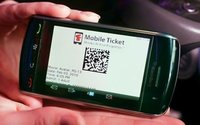 One of the key drivers of mobile
payments is recurring use.
One of the key drivers of mobile
payments is recurring use.
The idea of getting someone to use a mobile phone to pay for something at a retail store visited maybe once or twice a month is a tough one.
It’s just
not enough of a benefit to change paying habits for something that happens once in a while.
But for recurring events, those that happen on a relatively frequent and repetitive basis, mobile
payments make sense.
Using a smartphone to pay at Starbucks is easy, for example. The screen reader is highly visible, people see others doing it and the experience is rapid. An added
incentive is that Starbucks provides Wi-Fi, so a phone is more likely to be out, at least to get connected.
And then as a later benefit, ordering and paying in advance allows a customer to
skip the line.
advertisement
advertisement
That experience is so far away from convincing a consumer to use a phone to pay for a dress or pair of pants.
One area finding mobile payments success on a regular and
growing basis is in ticketing.
It turns out the number of people using contactless ticketing via mobile or even wearable devices will approach 300 million within five years, according to new
research.
The most established ticketing arena is around airline app ticketing followed by event ticketing, according to the study by Juniper Research.
The airline industry had the
highest annual growth, with in-app ticketing users increasing 50%. In addition, bookings made using an app are expected to grow about 40% this year.
While retailers like Walmart hope to
persuade shoppers to pull out their phones to pay before heading out of the store, those selling tickets are finding purchases more than willing to pay without cash or credit card again and again.
It’s that habit of doing the same thing in the same way over and over again that wins over ticket buyers.
In four years, nearly 23 billion transportation and events tickets will be
purchased globally using mobile handsets, more than twice the volume expected this year.
As context, online sales of digital goods and services generated $1 trillion over the last year. Of
that, mobile and online ticket sales accounted for some 88%.
In entertainment and metro bus ticketing, mobile far exceeds that of online ticketing, according to Juniper.
Ticketing
websites seem to helping that along. Some examples:
- Live Nation had a record year with more than 530 million tickets delivered. The company reported a 20% increase in mobile ticket
sales for the year.
- Fandango increased online ticket sales by 70% with mobile accounting for more than half of that.
- StubHub made about $700 million on $3 billion in ticket sales
in a year.
Airlines also are looking to extend activity somewhat beyond the smartphone.
Nearly a third of airports are planning to evaluate at last one wearable technology
within the next two years with more than 10% planning a major program. As might be expected, the smartwatch is at the center of that action.
But despite all its capabilities, smartphones at
airports are used by only 8% of passengers to check in, although that’s expected to double over the next year. At least that’s for mobile apps.
Mobile website airline check-in is
even lower, at 3% of passengers.
This may surprise many business travelers, who routinely flash a phone code as they pass security.
The other potential coming for mobile ticketing is
in using beacons, commonly viewed as mostly at home in retail.
In one trial, a major train operator installed a system in London using beacons and smartphones. It required travelers to carry a
smartcard and smartphone with the app. The service logs the beacons that the traveler has passed and applies the best train fare for the journey the customer makes.
Mobile payments may not be
soaring at retail, but for ticketing it’s a totally different story.
One mobile payment at a time, over and over and over again.